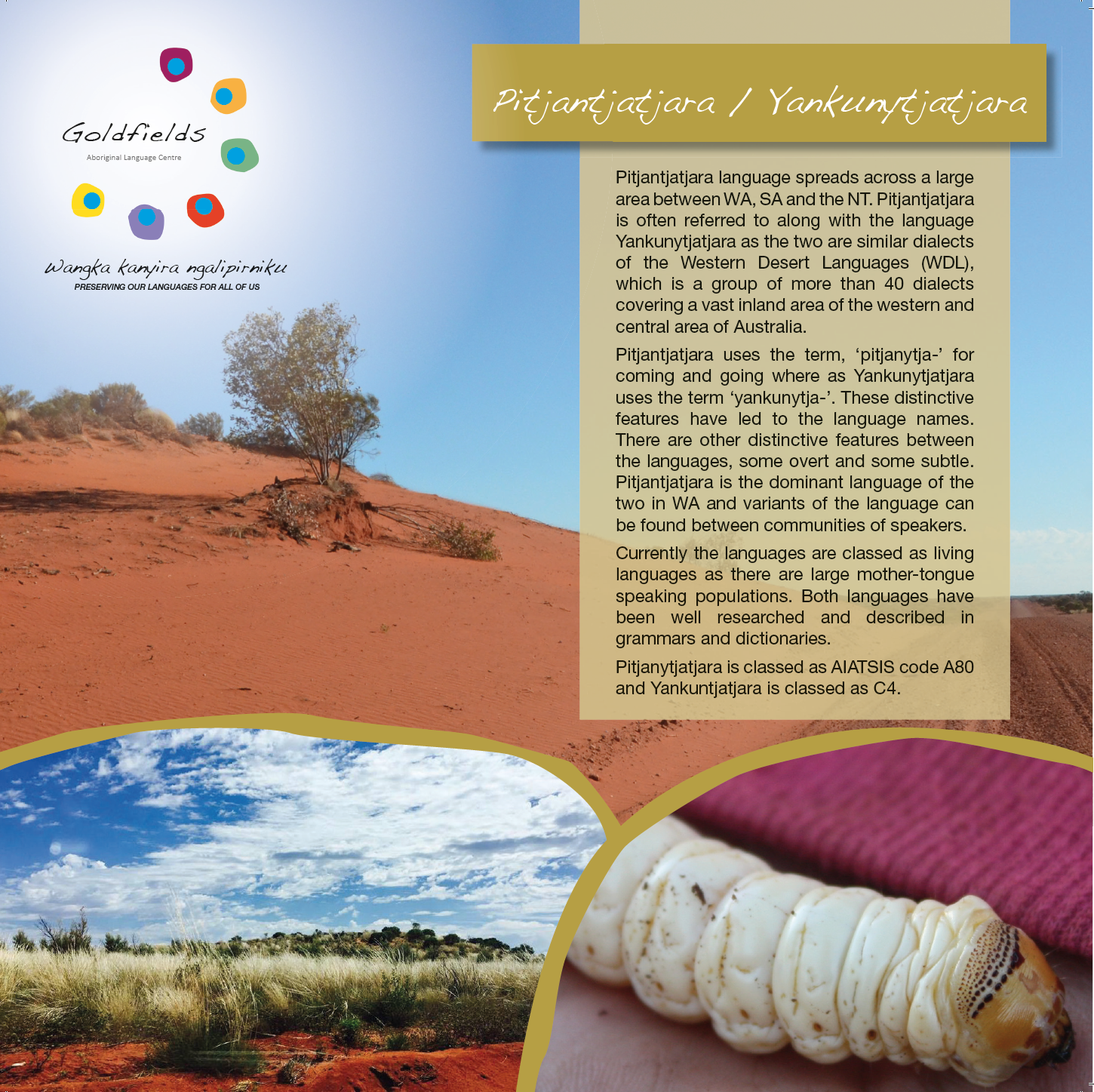
Some speakers refer to their language as Yankunytjatjarra and some refer to the language as Yankunytjatjara. In WA, the spelling convention is to use ‘rr’ for the trilled or tapped ‘r’ sound. In SA spelling conventions, some linguists used the single ‘r’ for the trilled or tapped ‘r’ sound.
Yankunytjatjarra speakers live in the north-east of Western Australia and the north-west of South Australia. Prior to their displacement by Pitjantjatjara speakers, in about 1917, Yankunytjatjarra communities inhabited the “Musgrave Ranges east of Oparinna, on Officer Creek; north to near Mount Robert, east to Everard Ranges, south to latitude 28°30” (see Tindale 1974, page 212).
Today, major Yankunytjatjarra centres include Indulkana and Mimili.
Resources for Yankunytjatjarra language material can be found on the Yankunytjatjarra Wangka website at wapar.net.au.
A list of Yankunytjatjarra and Pitjantjatjarra medical and health care terms and audio recordings can be found on the SA’s Mobile Language Team’s website here.
Here are some audio clips of words in the Yankuntjatjarra language from the SA Mobile Language Team’s website.
Dictionary
An online dictionary resource in this language can be found here.
Alphabet
l
like the ‘l’ sound in little, lost.
l
the line underneath means that it is made by drawing the tip of the tongue a little bit back in the mouth. This is a sound that English does not have.
ly
the ‘l’ and ‘y’ go together to represent one sound, not two separate sounds. Whenever you see ‘ly’, the sound is like the ‘ll’ in million.
m
like the ‘m’ in mother.
n
like the ‘n’ in net and win.
ng
the ‘n’ and ‘g’ go together to represent one sound, not two separate sounds. The sound ‘ng’ is similar to English singer, thing, wrong, rang. Yankunytjatjara does not have this sound at the end of a word, but often at the beginning and in the middle of words. In English the ‘ng’ sound is pronounced when ‘n’ and ‘k’ are written together, but in Yankunytjatjara ‘nk’ are not the same as the ‘ng’ sound. Some non-Anangu often pronounce Yankunytjatjara as Yangkunytjatjara (where the first syllable sounds almost like the English ‘young’), but this is wrong. The sounds in the English words ‘think’ and ‘finger’ are not the same as Yankunytjatjara ‘ng’, but would be spelt ‘ngk’ in Yankunytjatjara (wangka, ‘language’).
n
the line underneath means that it is made by drawing the tip of the tongue a little bit back in the mouth. This is a sound that English does not have. The American English pronunciation of barn, or corn is similar to the n.
ny
the ‘n’ and ‘y’ go together to represent one sound, not two separate sounds. Many English speakers have a similar sound in canyon, onion.
p
similar to the ‘p’ in spill, or spot. This is a sound which is quite similar to ‘b’, since it has no puff of air after it. You could use either ‘p’ or ‘b’, as in this language, they represent the same phoneme (sound). However, the ‘p’ has been chosen.
rr
Trilled or tapped ‘r’ sound, similar to English better, butter, letter, and ladder if spoken fast. The tongue taps towards the roof of the mouth, or rolls slightly. Spanish and many other European languages have a similar sound, and some English dialects have a very similar ‘rolled r’ (Scottish English). This sound never starts a word, so whenever you see an ‘r’ written in the beginning of a word, say r (the ‘ordinary English’ r-sound) instead of r.
r
similar to English run, real, and very. This ‘r’ sound is made by drawing the tongue tip a little back in the mouth. This sound can be found in the beginning and in the middle of words, but never at the end of a Yankunytjatjara word.
t
similar to English steel, or storm. This is a sound similar to ‘d’, since it has no puff of air after it. You can use either ‘t’ or ‘d’, the difference between these two sounds is not important. t this is a sound similar to the ‘t’ above,
t
this is a sound similar to the ‘t’ above, but with the tongue tip drawn a little back in the mouth.
tj
the ‘t’ and ‘j’ go together to represent one sound, not two separate sounds. The ‘tj’ is very similar to English judge, jam.
u
this sound can be heard as in the English you, put. It sounds quite similar to saw when it is before a ‘w’ (but not when it is after a ‘w’).
uu
little bit longer than the ‘u’, as in pool.
w
similar to the English will, would, want, away.
y
similar to the English you, yes, yard.
a
similar to the sounds in about, sofa, or but.
aa
little bit longer than ‘a’, like the a in father.
i
like the ‘i’ sounds of in, wind.
ii
little bit longer than ‘i’. Sounds like the end of the words three, see, or be.
k
this often sounds like the ‘k’ in skate, kid, or like the ‘c’-sounds in Scottish, or scar. It is a sound quite similar to ‘g’, since it has no puff of air after it. You can use either ‘k’ or ‘g’, the difference between these two sounds is not important.
GALCAC Yankuntjatjarra Resources
GALCAC has a beautiful alphabet chart in Yankunytjatjarra language. A smaller downloable version of the charts can be found below. The charts at GALCAC are laminated, rip free and priced at $40.
A downloadable version of the Yankuntjatjarra alphabet chart is available here.
A downloadable version of the Yankuntjatjarra body parts chart is available here.
